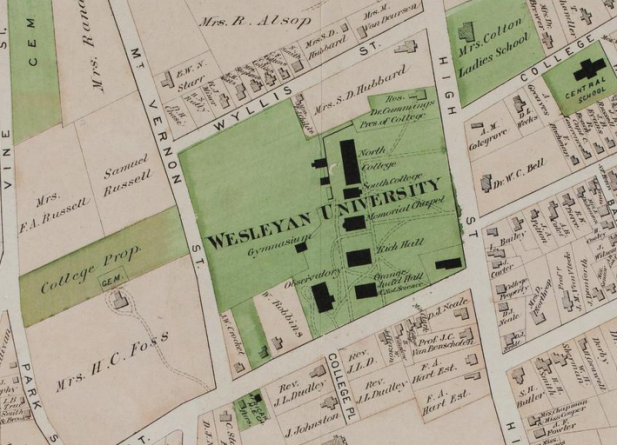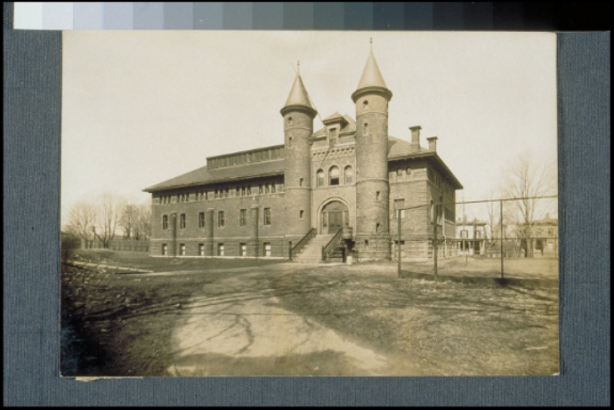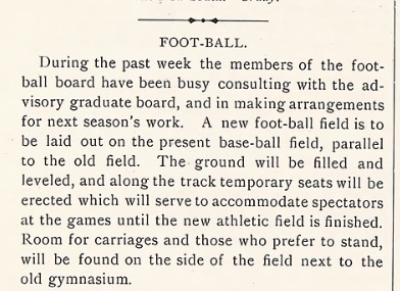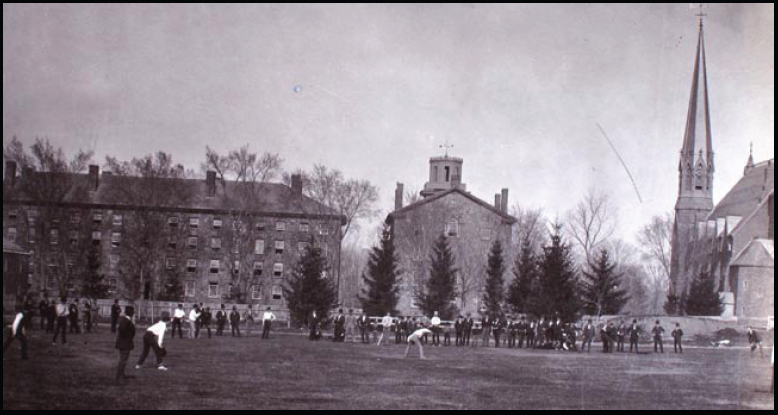by Sage Marshall
In the center of Wesleyan University’s campus lies a rectangle of deep green grass named Andrus Field. Today, it contains a football field, a baseball diamond, and also serves as a gathering place for the university community. Wesleyan promotes Andrus as the “oldest continuously used football field in North America,” and its evolution paralleled the growth of collegiate athletics in America. Fully developed in 1898, the historic field originated from a radical shift in the way that Americans related to the environment.
When Wesleyan University opened in 1831, sports were not part of the college experience. The fallow plot of land that became Andrus Field (sometimes referred to as the “back lot,”) was neither a regulated athletic field nor at the center of campus, and generally consisted of swampland and grazing land for cattle.
The Rise of Physical Education at Wesleyan

Detail of Wesleyan University from the County Atlas of Middlesex, Connecticut : from actual surveys by F.W. Beers, 1874. Note the location of the Gymnasium.
In the mid-19th century, the mostly upper-class students and faculty decided to begin counteracting their increasingly sedentary urban lifestyle through exercise. The gymnastics and calisthenics of the time were crude responses to Americans’ concerns about health that resulted from a fear of physical degeneracy. Although founding President Wilbur Fisk suggested the school offer physical education, even the most basic of gymnasiums did not appear on campus until 1864.
Unfortunately, the students found the standard gym workouts boring, and the gym cold and drafty. They did not feel connected with the environment in the same way that outdoor sports allowed. While the students felt obligated to exercise for health reasons, the gymnastics were far from the well-developed collegiate sports that followed. Regardless, the start of gymnastics and calisthenics at Wesleyan mirrored a national shift in American attitudes that promoted people taking greater control over their bodies.
As demonstrated by the start of the baseball team in 1864, students eventually became interested in team sports as a form of fitness, though Wesleyan’s team tended to lose by large margins in relatively high-scoring games. Writers for the Wesleyan Argus (the student newspaper) justified some of these losses by complaining that the team had to practice on the “back lot” which was uneven and had high grasses. Although the university did not value the baseball team enough to give them their own field, the team persisted and its rise in popularity helped facilitate the growth of team sports at Wesleyan.

Fayweather gymnasium ca. 1910, Wesleyan University, Middletown, Connecticut – Connecticut Historical Society
Collegiate Athletics Changes the Local Landscape
The rapid evolution of football at Wesleyan in the late 18th century provided the impetus for the university to finally build Andrus field and accept team athletics as an integral part of school life. Although students played pickup football on the land since at least the early 1870s, the university did not organize its first team until 1881.

Detail from the Wesleyan Argus, July 6, 1892 – Wesleyan University, Wesleyan Argus Digital Archives
The team used the land that eventually became Andrus field, still uneven and swampy, because football was a primitive, unorganized game with few recognized rules. During the mid-1880s football evolved into a more uniform game, and Wesleyan moved to the forefront of major collegiate football, playing the likes of Yale, Harvard, and Princeton. Thus, in 1892, the university took steps to flatten the field, but the full draining and clearing to create a standard athletic field did not occur until 1898. Around this time, alumni donations funded Fayweather gymnasium in 1894, which bordered Andrus field. These adjoining athletic spaces literally shifted the center of campus around the field, symbolic of the central role that athletics came to play at the university.
By the early 19th century, athletics were a significant attraction for the university. In 1902 donors funded a grandstand for Andrus field (recognizing spectators’ affinity for football), and in an October 12, 1911, edition of the Wesleyan Argus, the university took out an ad that promoted the “ample athletic field [that] adjoins the campus.” Evidently, the university not only accepted Andrus field as an important part of the campus, but promoted it to attract students.
As George S. Counts (a professor at Columbia University Teachers College) stated in a 1929 lecture on Secondary Education and Industrialization, “We have been literally precipitated into a new world: a world which with a ruthless and relentless energy is destroying inherited values, creeds, and faiths.” To counteract these challenges Americans gradually developed athletics to adapt to their new environments. To offer students the benefits of athletics, the university created Andrus Field. This adaptation of the land to meet the changing needs of the university community is one that is still in use today.
Sage Marshall authored this piece while a student at Wesleyan University as part of a class project in environmental history.









